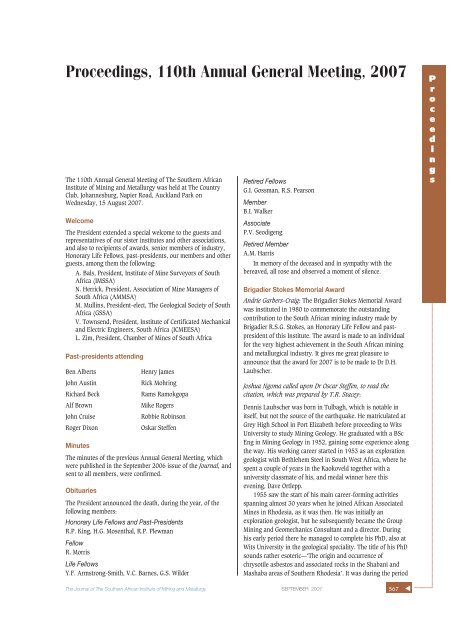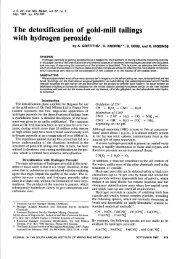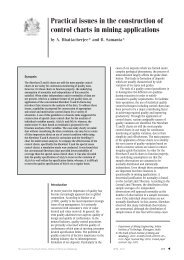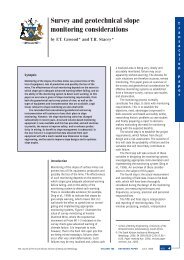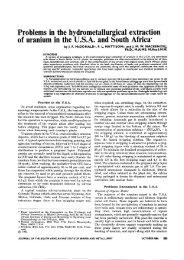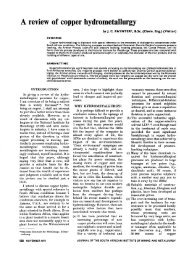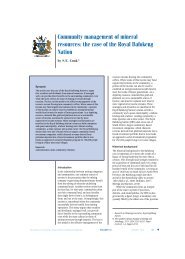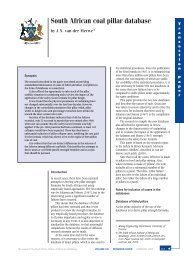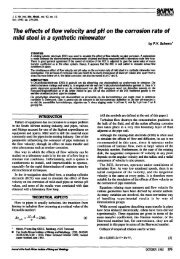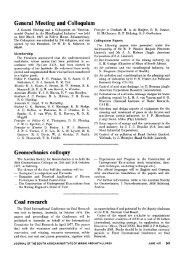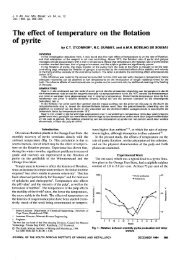SAIMM Journal
SAIMM Journal
SAIMM Journal
Create successful ePaper yourself
Turn your PDF publications into a flip-book with our unique Google optimized e-Paper software.
Proceedings, 110th Annual General Meeting, 2007<br />
The 110th Annual General Meeting of The Southern African<br />
Institute of Mining and Metallurgy was held at The Country<br />
Club, Johannesburg, Napier Road, Auckland Park on<br />
Wednesday, 15 August 2007.<br />
Welcome<br />
The President extended a special welcome to the guests and<br />
representatives of our sister institutes and other associations,<br />
and also to recipients of awards, senior members of industry,<br />
Honorary Life Fellows, past-presidents, our members and other<br />
guests, among them the following:<br />
A. Bals, President, Institute of Mine Surveyors of South<br />
Africa (IMSSA)<br />
N. Herrick, President, Association of Mine Managers of<br />
South Africa (AMMSA)<br />
M. Mullins, President-elect, The Geological Society of South<br />
Africa (GSSA)<br />
V. Townsend, President, Institute of Certificated Mechanical<br />
and Electric Engineers, South Africa (ICMEESA)<br />
L. Zim, President, Chamber of Mines of South Africa<br />
Past-presidents attending<br />
Ben Alberts<br />
John Austin<br />
Richard Beck<br />
Alf Brown<br />
John Cruise<br />
Roger Dixon<br />
Minutes<br />
Henry James<br />
Rick Mohring<br />
Rams Ramokgopa<br />
Mike Rogers<br />
Robbie Robinson<br />
Oskar Steffen<br />
The minutes of the previous Annual General Meeting, which<br />
were published in the September 2006 issue of the <strong>Journal</strong>, and<br />
sent to all members, were confirmed.<br />
Obituaries<br />
The President announced the death, during the year, of the<br />
following members:<br />
Honorary Life Fellows and Past-Presidents<br />
R.P. King, H.G. Mosenthal, R.P. Plewman<br />
Fellow<br />
R. Morris<br />
Life Fellows<br />
Y.F. Armstrong-Smith, V.C. Barnes, G.S. Wilder<br />
Retired Fellows<br />
G.I. Gossman, R.S. Pearson<br />
Member<br />
B.I. Walker<br />
Associate<br />
P.V. Seodigeng<br />
Retired Member<br />
A.M. Harris<br />
In memory of the deceased and in sympathy with the<br />
bereaved, all rose and observed a moment of silence.<br />
Brigadier Stokes Memorial Award<br />
Andrie Garbers-Craig: The Brigadier Stokes Memorial Award<br />
was instituted in 1980 to commemorate the outstanding<br />
contribution to the South African mining industry made by<br />
Brigadier R.S.G. Stokes, an Honorary Life Fellow and pastpresident<br />
of this Institute. The award is made to an individual<br />
for the very highest achievement in the South African mining<br />
and metallurgical industry. It gives me great pleasure to<br />
announce that the award for 2007 is to be made to Dr D.H.<br />
Laubscher.<br />
Joshua Ngoma called upon Dr Oscar Steffen, to read the<br />
citation, which was prepared by T.R. Stacey:<br />
Dennis Laubscher was born in Tulbagh, which is notable in<br />
itself, but not the source of the earthquake. He matriculated at<br />
Grey High School in Port Elizabeth before proceeding to Wits<br />
University to study Mining Geology. He graduated with a BSc<br />
Eng in Mining Geology in 1952, gaining some experience along<br />
the way. His working career started in 1953 as an exploration<br />
geologist with Bethlehem Steel in South West Africa, where he<br />
spent a couple of years in the Kaokoveld together with a<br />
university classmate of his, and medal winner here this<br />
evening, Dave Ortlepp.<br />
1955 saw the start of his main career-forming activities<br />
spanning almost 30 years when he joined African Associated<br />
Mines in Rhodesia, as it was then. He was initially an<br />
exploration geologist, but he subsequently became the Group<br />
Mining and Geomechanics Consultant and a director. During<br />
his early period there he managed to complete his PhD, also at<br />
Wits University in the geological speciality. The title of his PhD<br />
sounds rather esoteric—‘The origin and occurrence of<br />
chrysotile asbestos and associated rocks in the Shabani and<br />
Mashaba areas of Southern Rhodesia’. It was during the period<br />
P<br />
r<br />
o<br />
c<br />
e<br />
e<br />
d<br />
i<br />
n<br />
g<br />
s<br />
The <strong>Journal</strong> of The Southern African Institute of Mining and Metallurgy SEPTEMBER 2007<br />
567<br />
▲
Proceedings, 110th Annual General Meeting, 2007<br />
at AA Mines that he developed his expertise in the area of<br />
block caving, with which his name is synonymous. With his<br />
expert knowledge and ability in the asbestos mining field, his<br />
services were in demand and, despite the sanctions in place<br />
against Rhodesia, he consulted to Bell Mine in Quebec and<br />
Cassiar Mine in British Columbia.<br />
It was in the 1970s that Dennis developed the rock mass<br />
classification system for which he has become famous. He<br />
initially tried out Bieniawski’s system, published in 1973, but<br />
found that it did not suit the cave mining environment in the<br />
asbestos mines, and so developed his own system, the mining<br />
rock mass rating system, which is now very widely used in the<br />
mining industry worldwide. There is not a block caving mine<br />
anywhere in the world that has not used his empirical<br />
correlation, or stability graph, to evaluate the cavability of its<br />
deposit. This is in spite of all the sophisticated computer<br />
programs available that are supposed to be able to simulate<br />
such behaviour. It is unlikely that the methods and empirical<br />
rules developed by Dennis will ever become replaced by other<br />
methods—they will be supplemented by new methods, but will<br />
not be replaced. Dennis’s system is also used for the<br />
determination of caving angles and hence the occurrence of<br />
cave cracks and extent of cave craters. It is also used for the<br />
estimation of slope angles in open pit mines.<br />
Dennis left Zimbabwe in 1984 and spent nearly four years<br />
with SRK Consulting in Johannesburg as a specialist mining<br />
consultant. During this period he spent about 6 months in<br />
Chile, a difficult time in that country’s history, participating in<br />
the planning of major caving operations. It was the traffic in<br />
Johannesburg that drove Dennis to leave SRK in 1987 and<br />
establish himself as an independent mining consultant, based<br />
in the more amenable resort of Bushman’s River Mouth/Kenton<br />
on Sea, where the fishing is good. Since 1987 he has carried<br />
out consulting assignments in many countries—Australia,<br />
Chile, Greece, Indonesia, Peru, Philippines, South Africa, USA.,<br />
Zambia and Zimbabwe.<br />
Dennis’s achievements have been recognized, and he was<br />
awarded an <strong>SAIMM</strong> Gold Medal for his publication in the<br />
<strong>SAIMM</strong> <strong>Journal</strong> in 1994, ‘Cave mining—state-of-the-art’. He<br />
has received a Lifetime Achievement Award from the South<br />
African National Institute of Rock Engineering, and in 2000, at<br />
the MassMin Conference in Brisbane, he was the first recipient<br />
of the De Beers Mass Mining Award. This is high praise, and<br />
something for which we, as fellow South Africans, can also be<br />
proud. He is the author of a Block Cave Manual, which was<br />
written for the international caving study, and this work<br />
collects together all the block caving experience that he has<br />
developed during his career. The mining world is fortunate to<br />
have had contributions of such calibre.<br />
On a personal level, I was very privileged to be able to work<br />
on a project in Chile with Dennis over a three-year period in the<br />
early 1990s. This was a great experience for me and it was<br />
during that period that my respect for Dennis deepened even<br />
further. Spending weeks at a time on site with him allowed for<br />
many discussions, and arguments. Any of you that know<br />
Dennis will know that he is a very difficult person to argue<br />
against. I have a picture of him as a table thumper, which he<br />
often did to emphasize that what he was saying was, without<br />
the slightest doubt, correct! This did not encourage argument,<br />
but I did enjoy arguing with him, and these arguments usually<br />
took place over dinner in the evenings. I remind him of the<br />
‘rule of the golden mean’ which appeared in a novel that he<br />
passed on to me during one of our Chilean visits. This rule<br />
stated, ‘If A is correct, this does not necessarily mean that B is<br />
wrong’. The next day Dennis would often grudgingly say<br />
something like, ‘Maybe what you were saying yesterday might<br />
have some merit’. He had been thinking about it during the<br />
night, and this is something that I remember about him so<br />
well—he was always thinking; and he is still thinking.<br />
In conclusion, Dennis Laubscher is a man who has made<br />
an enormous technical contribution to the world of block<br />
caving. He has been involved in some way with most of the<br />
major caving operations in the world, and on those on which<br />
he has not had direct involvement, he has been indirectly<br />
involved through the mines’ use of his MRMR, and other<br />
caving design rules. He is truly international figure and is<br />
indeed a very worthy recipient of the Brigadier Stokes Award.<br />
D.H. Laubscher: Mr Chairman, Ladies and Gentlemen. It is a<br />
great honour for me to receive the Brigadier Stokes award.<br />
My success in the mining industry can be put down to<br />
being in the right place at the right time with the right people.<br />
The right places and time were the chrysotile asbestos mines of<br />
Zimbawe, Swaziland and Canada during the ’60s and ’70s and<br />
the copper mines of Chile in the ’80s. The right people were<br />
excellent colleagues and an understanding management who<br />
saw the need to solve the mining problems with financial<br />
support for large- and small-scale mining test work.<br />
The geology of the Asbestos mines is complex with a range<br />
in ground conditions from weak and strong footwall rocks and<br />
weak to strong ore host rocks. Shabanie Mine in Zimbabwe,<br />
which started mining in 1918, has more that 50 orebodies<br />
ranging in size from 1 million to 10 million tons. During my<br />
period on the mines there were open pits, cut and fill stopes,<br />
open stopes, sub-level caving with hand and mechanized<br />
tramming, grizzly block caves, horizontal mechanized block<br />
caves, and incline caves. All in, rock masses ranging from class<br />
5 to class 2.<br />
The UDI period in Rhodesia meant that we were cut off<br />
from the U K parent body and had to solve our own problems<br />
with help from our South African counterparts such as the CSIR<br />
and De Beers. One important aspect was that the sales were<br />
now in our hands and they increased significantly, with the<br />
result that there was a need for a major increase in production.<br />
This meant new shafts to open up lower levels. We had to put<br />
in place mining methods, support systems and controls that<br />
ensured continued production in difficult mining environments.<br />
Draw control became a major issue and resulted in sound<br />
techniques being developed from large physical models and<br />
underground marker experiments.<br />
Visits to Canada during UDI were conducted undercover as<br />
Rhodesians were not accepted. These trips involved setting up<br />
▲<br />
568 SEPTEMBER 2007 The <strong>Journal</strong> of The Southern African Institute of Mining and Metallurgy
Proceedings, 110th Annual General Meeting, 2007<br />
a new mining area on Bell Mine, Quebec with an LHD layout in<br />
place of an existing grizzly layout. On Cassiar Mine in remote<br />
northern Britsh Columbia an underground method in a deeper<br />
orebody had to be designed to replace an open pit. In this case<br />
management decisions of running hot and cold on the<br />
implementation did prejudice the final result, even though<br />
production did take place.<br />
The visits to Chile started in ’85 to design new mining<br />
methods on one of the mines. This was an experience as one<br />
was now dealing with mines where the daily tonnage was<br />
nearly the same as the monthly tonnages one was used to. It<br />
was possible to make contributions but, what was significant<br />
was top management's reluctance to spend money on largescale<br />
research projects. High stress environments and rock<br />
bursts were a different situation to squeezing ground on the<br />
asbestos mines, but all good experience and the advanced<br />
undercutting concept were developed here.<br />
I feel that one of the problems today is the reliance on<br />
computer programs to solve problems. After all ‘numerical<br />
models solve equations, people solve problems’.<br />
More hands-on work is required: when one draws sections<br />
or plans by hand, discrepancies are noticed and investigated. I<br />
suppose I will be told I am out of touch and should stick to<br />
fishing—thank goodness we still do that by hand. Thank you.<br />
Gold Medals<br />
O.K.H. Steffen, P.J. Terbrugge, J. Wesseloo, and J. Venter for<br />
their paper published in the July 2006 issue of the <strong>Journal</strong><br />
entitled:<br />
‘A risk consequence approach to open pit slope design’.<br />
Silver Medals<br />
W.D. Ortlepp and T.R. Stacey for their paper published in the<br />
May 2006 issue of the <strong>Journal</strong> entitled:<br />
‘Assessment of the risk plug or water barrier failure due to<br />
seismicity as South Deep Gold Mine’.<br />
T.R. Stacey for his paper published in the July 2006 issue of<br />
the <strong>Journal</strong> entitled:<br />
‘Considerations of failure mechanism associated with rock<br />
slopes instability and consequences for stability analysis’,<br />
and<br />
A. Anyimadu, C. Rule, and L. Knopjes for their Transaction<br />
paper published in the January 2007 issue of the <strong>Journal</strong><br />
entitled:<br />
‘The development of ultra fine grinding at Anglo Platinum’.<br />
As a non-member L. Knopjes received a certificate of merit.<br />
Presentation of Student Prizes<br />
P<br />
r<br />
o<br />
c<br />
e<br />
e<br />
d<br />
i<br />
n<br />
g<br />
s<br />
Presentation of awards, medals and certificates<br />
Joshua Ngoma announced the following awards, medals and<br />
certificates, which were presented by Pat Willis.<br />
50-year Membership Awards<br />
(with effect from 1 July 1956 to 30 June 1957)<br />
➤ G.A. Brown, elected 10 May 1957<br />
➤ D.R. Chelius, elected 10 May 1957<br />
➤ M.F. Dawson, elected 10 May 1957<br />
➤ L.M. Falcon, elected 10 August 1956<br />
➤ M.A. Madeyski, elected 8 February 1957<br />
➤ D. Rankin, elected 9 November 1956<br />
➤ G.C. Thompson, elected 14 June 1957<br />
Presentation of the Alec Wilson Memorial Award<br />
John Cruise: This gets awarded for the best tunnelling paper by<br />
a South African worldwide or presented in South Africa. The<br />
award of R1 000.00 is sponsored by GOBA (Pty) Ltd.<br />
The 2006 prize goes to R.G.B. Pickering and K. Moxham<br />
for their paper entitled:<br />
‘The development and implementation of the Lonmin<br />
mechanized breast mining’<br />
published in the <strong>SAIMM</strong> publication: International Platinum<br />
Conference—‘Platinum Surges Ahead’.<br />
Transaction papers published in the <strong>Journal</strong> from March<br />
2006 to February 2007 by members of the Institute were<br />
considered and then the following medals were awarded:<br />
Joshua Ngoma announced the student winners of the <strong>SAIMM</strong><br />
Prestige Prize and Pat Willis presented the awards to the<br />
students adjudged by their departments to be the best finalyear<br />
students in 2006:<br />
University of the Witwatersrand<br />
Mining<br />
B. Uugwanga<br />
Metallurgy<br />
M. Shongwe<br />
University of Pretoria<br />
Mining<br />
C.H. Cloete<br />
Metallurgy<br />
N. Botha<br />
The following <strong>SAIMM</strong> student prizes were presented at the<br />
Western Cape Branch AGM on 2 August 2007.<br />
University of Cape Town<br />
Chemical Engineering A. Schoeman<br />
University of Stellenbosch<br />
Process Engineering P.C. du Plessis<br />
Cape Peninsula University of Technology<br />
Chemical Engineering Y. Zhou<br />
Annual Report and Accounts<br />
John Cruise presented the financial statements.<br />
Last year I reported that we had had six successful years<br />
financially and that I hoped that our ‘run of fat years will<br />
extend to the biblical seven’. I am pleased to report that this is<br />
indeed so.<br />
The <strong>Journal</strong> of The Southern African Institute of Mining and Metallurgy SEPTEMBER 2007<br />
569<br />
▲
Proceedings, 110th Annual General Meeting, 2007<br />
If we look at our Income Statement summary, we see that<br />
our surplus for the year was R4 165 927 (R3 738 041), of<br />
which R1 332 858 (R489 534) was operating surplus and<br />
R2 836 945 (R3 248 685) was income from investments.<br />
The Detailed Income Statement shows that subscriptions<br />
for Company Affiliates increased to R437 981 (R377 930) and<br />
that for Individual Memberhip increased to R1 169 698<br />
(R944 369). As this is an increase above the annual<br />
subscription rate increase, it indicates an increase in<br />
membership numbers.<br />
Conferences, colloquia, etc. showed a slight decrease from<br />
last year’s record surplus to R1 740 513 (R1 981 615). This<br />
can be ascribed to conferences being held at either side of the<br />
financial year end. This excellent income for two years running<br />
lies at the door of not only the two technical programme<br />
committees, who have not only held world-class conferences in<br />
both their content and numbers, but also the <strong>SAIMM</strong><br />
Secretariat in their organization and attention to containing<br />
costs.<br />
Income from investments showed an increase in dividend<br />
revenue of R272 087 (R242 677), an increase in interest<br />
received of R157 623 (R67 818), a decrease in the amount that<br />
the investment portfolio has increased to R2 095 489<br />
(R2 689 611) and an increase in the value of assets sold to<br />
R311 746 (R248 579).<br />
Expenditure for the year decreased to R2 015 334<br />
(R2 814 380). This was made up in the main by a decrease in<br />
administration and secretarial costs to R1 116 178<br />
(R1 710 100) due to the fair allocation of these costs to the<br />
conferences, an increase in <strong>Journal</strong> secretarial fees to R131 590<br />
(R113 798), a decrease in <strong>Journal</strong> expenses to R1 367 786<br />
(R1 444 031), with a commensurate increase in advertising<br />
revenue to R712 720 (R553 773), with the same number of<br />
<strong>Journal</strong>s for this year as last year, and an increase in<br />
depreciation to R94 500 (R75 224).<br />
Our listed investments increased by 37% to R11 529 514<br />
(R8 426 352). Our cash and cash equivalents increased to<br />
R3 237 763 (R3 087 087). Our total assets increased during<br />
the year to R17 982 998 (R12 798 538), and total liabilities<br />
increased to R2 290 243 (R1 496 662).<br />
Again, this year's financial success is due to many people<br />
whose unstinting work often goes unnoticed or is accepted at<br />
the Institute and by our members as the norm. To the members<br />
who serve voluntarily on the Institute's committees, a huge<br />
debt is owed, thank you. To the Secretariat who are the<br />
cogs in the wheel of our Institute, thank you. To Serena<br />
Jackson, our bookkeeper, who took over the accounting<br />
function a few months ago at short notice, well done. To our<br />
auditors R.H. Kitching who produced these Financial<br />
Statements in the limited time available between our year end<br />
and our AGM, thank you. To Dawn van der Walt and Zuliakho<br />
Malgas of our Desktop Publishing department who got the<br />
Annual Report to the printers on time, yet again, well done.<br />
Finally, I would like to draw members’ attention to the<br />
Statement of Changes in Reserves, which in old-fashioned<br />
parlance is Changes in Equity. The following are the Changes<br />
in reserves for the past seven years:<br />
Year Change Reserve<br />
R<br />
R<br />
2000 998 193<br />
2001 803 8161 802 009<br />
2002 1 607 9243 409 933<br />
2003 575 730 3 982 633<br />
2004 2 676 028 6 658 661<br />
2005 1 094 849 7 753 510<br />
2006 3 548 366 11 301 876<br />
2007 4 390 879 15 692 755<br />
The biblical seven fat years have been achieved. We now have<br />
a war chest with which we can do great things.<br />
Office bearers and Members of Council for 2007/2008<br />
Pat Willis announced the office bearers for the ensuing year,<br />
elected by the retiring Council in accordance with Clauses 3.2<br />
and 3.3 of the Constitution:<br />
President<br />
R.G.B. Pickering<br />
President-elect<br />
A.M. Garbers-Craig<br />
Senior vice-president<br />
J. Ngoma<br />
Junior vice-president<br />
G.V.R. Landman<br />
Immediate past-president R.P.H. Willis<br />
Honorary treasurer<br />
J.A. Cruise.<br />
In terms of the election of ordinary members of Council<br />
(bylaw 3.2.7), there is a letter from the scrutineers stating: ‘We<br />
have to report that we inspected the nomination papers for<br />
members of Council for the 2007/2008 session, and have<br />
found that the ballot papers sent out to Corporate Members of<br />
the Institute were in order. As a result of our scrutiny, we find<br />
that the following members have been elected (in alphabetical<br />
order):<br />
A.M. Clegg<br />
J.L. Porter<br />
R.C. Croll<br />
J.H. Potgieter<br />
P.H. Ferreira<br />
M.K.C. Roberts<br />
M.F. Handley<br />
C.B. Sheppard<br />
R.T. Jones<br />
G.L. Smith<br />
A.S. Macfarlane<br />
J.N. van der Merwe<br />
M.J. Mothomogolo<br />
D.J. van Niekerk<br />
In addition, A.F. Mulaba-Bafubiandi and P.J. Knottenbelt<br />
have agreed to represent non-corporate members on Council.<br />
Four additional members will be co-opted to serve on Council.<br />
In terms of Clause 3.2.8 of the Constitution, the chairmen<br />
of the branches are as follows:<br />
Botswana<br />
J. Arthur<br />
Bushveld<br />
C.A.F. Sweet<br />
Free State<br />
Vacant<br />
Johannesburg<br />
U. Sachse<br />
▲<br />
570 SEPTEMBER 2007 The <strong>Journal</strong> of The Southern African Institute of Mining and Metallurgy
Proceedings, 110th Annual General Meeting, 2007<br />
Mpumalanga<br />
Vacant<br />
Namibia<br />
D. Garbers<br />
Pretoria<br />
I. Matunhire<br />
Western Cape<br />
A. Burger<br />
Zambia<br />
S. Simukanga<br />
Zululand<br />
I.J. Walton<br />
These chairmen will serve on Council.<br />
The following past-presidents have signified their willing -<br />
ness to serve on Council for the ensuing year:<br />
N.A. Barcza<br />
R.D. Beck<br />
L.A. Cramer<br />
J.A. Cruise<br />
J.R. Dixon<br />
F.M.G. Egerton<br />
H.E. James<br />
R.P. Mohring<br />
S.J. Ramokgopa<br />
M.H. Rogers<br />
D.A.J. Ross-Watt<br />
T.R. Stacey<br />
Pat Willis thanked those past-presidents, who indicated that<br />
they cannot serve on Council for the next year, for all their<br />
time, effort and dedication in the past.<br />
He also thanked past-presidents for their continued<br />
support. He congratulated all those elected, and thanked those<br />
who agreed to serve another term of office.<br />
Election of auditors and honorary legal advisers for<br />
2007/2008<br />
Pat Willis proposed and it was agreed, that R.H. Kitching be<br />
reappointed as auditor for the coming year and that Van<br />
Hulsteyn, Attorneys be reappointed as honorary legal advisers.<br />
Induction of President<br />
Pat Willis introduced the new President, Rod Pickering and<br />
called upon Andrie Garbers-Craig to read his curriculum vitae.<br />
Rod grew up in Yorkshire and was educated in Dorset. He<br />
started work in 1960 when he joined Shell Tankers as an<br />
engineering apprentice. There he completed a training<br />
programme for merchant navy engineering officers. He had<br />
nearly three years of general maintenance in marine and steam<br />
raising plant. He learnt the basics of engineering from the<br />
ground up, and today he is still a competent fitter and welder.<br />
In 1965 he enrolled at Brighton College of Technology where<br />
he obtained a BSc Honours in Mechanical Engineering.<br />
He arrived in South Africa in 1969 and started work on the<br />
mines as a Junior Engineer with Union Corporation. There he<br />
obtained his Mechanical Engineer’s Certificate of Competency.<br />
He moved from the mines and worked in maintenance, sales<br />
and construction for a period of six years. His last position was<br />
that of contracts manager on the Pelindaba uranium<br />
enrichment site.<br />
He joined the Chamber of Mines Research Organization in<br />
1977, and the highlight of his time with COMRO was being<br />
appointed director of the Stoping Technology Laboratory with<br />
the responsibility to develop ways of mechanizing the narrow<br />
reef hard rock gold mines. It was while at the Chamber that he<br />
gained a good understanding of the opportunities and the<br />
barriers inhibiting change in the mining industry.<br />
In late 1996 he started his own business combining his<br />
knowledge of mechanisation and mining. His first task was to<br />
investigate the practicality of using a tunnel boring machine in<br />
a deep-level gold mine.<br />
Since 1998 his major client has been Sandvik Mining and<br />
Construction where his role is that of Manager of Strategic<br />
Projects, with special responsibility for narrow reef and narrow<br />
vein mining throughout the world. His objective is to develop<br />
new mining processes in collaboration with customers. These<br />
new mining processes will use existing technology, or new<br />
technology that has to be specially developed. The ultimate<br />
objective is safer more cost-effective mining. The last few years<br />
have resulted in low profile and xtra low profile mining<br />
equipment as well as a novel rock cutting machine.<br />
Rod is passionate about working within the mining<br />
industry to introduce change. His dream is to be part of that<br />
change that will transform the narrow reef hard rock mining<br />
industry and South Africa. He has been a Fellow of the <strong>SAIMM</strong><br />
since 1985 and believes that it is important to give back to the<br />
mining industry. Rod is married to Avonne and they have two<br />
children, Robyn and Simon. In his spare time he fishes and<br />
relaxes in the beautiful South African countryside.<br />
Presidential Address<br />
Rod Pickering then presented his presidential address entitled:<br />
‘Has the South African narrow reef mining learnt how to<br />
change?’, which is reproduced elsewhere in this edition of the<br />
<strong>Journal</strong>.<br />
Vote of thanks<br />
Noel Joughin, gave the vote of thanks.<br />
Closure<br />
The meeting closed at 18:00.<br />
◆<br />
P<br />
r<br />
o<br />
c<br />
e<br />
e<br />
d<br />
i<br />
n<br />
g<br />
s<br />
The <strong>Journal</strong> of The Southern African Institute of Mining and Metallurgy SEPTEMBER 2007<br />
571<br />
▲
Proceedings, 110th Annual General Meeting, 2007<br />
Pat Willis declaring the Annual General<br />
Meeting open<br />
Joshua Ngoma, Master of Ceremonies<br />
Oskar Steffen reading the citation of<br />
D.H. Laubscher, recipient of the<br />
Brigadier Stokes Award<br />
D.H. Laubscher, recipient of the Brigadier Stokes<br />
Award, receiving his Platinum Medal from<br />
Pat Willis<br />
D. Rankin receiving his 50-year Membership<br />
lapel badge from Pat Willis<br />
Rod Pickering receiving the Alec Wilson<br />
Memorial Award from John Cruise for 2006<br />
P.J. Terbrugge and O.K.H. Steffen, receiving their Gold<br />
Medal Awards<br />
W.D. Ortlepp, receiving his Gold Medal Award<br />
A. Anyimadu, receiving his Silver Medal Award<br />
▲<br />
572 SEPTEMBER 2007 The <strong>Journal</strong> of The Southern African Institute of Mining and Metallurgy
Proceedings, 110th Annual General Meeting, 2007<br />
P<br />
r<br />
o<br />
c<br />
e<br />
e<br />
d<br />
i<br />
n<br />
g<br />
s<br />
B. Uugwanga from the University of the<br />
Witwatersrand, receiving his Student Prize<br />
M. Shongwe from the University of the<br />
Witwatersrand, receiving his Student Prize<br />
Gys Landman reading Rod<br />
Pickering’s CV<br />
Rod Pickering presenting Pat Willis with his<br />
Presidential Plaque<br />
Rod Pickering, delivering his<br />
Presidential Address<br />
Noel Joughin offering the vote of thanks<br />
<strong>SAIMM</strong> staff: Julie Dixon, Dawn v.d. Walt, Carina Reynders (Manager)<br />
and Shahida Moosa<br />
Office Bearers for 2007/2008—Front row (from left to right):<br />
Joshua Ngoma, Carina Reynders (Manager), Rod Pickering, and Pat Willis;<br />
Back row (from left to right): Gys Landman and John Cruise<br />
The <strong>Journal</strong> of The Southern African Institute of Mining and Metallurgy SEPTEMBER 2007<br />
573<br />
▲
Proceedings, 110th Annual General Meeting, 2007<br />
Past presidents of the <strong>SAIMM</strong><br />
Front row (from left to right): Mike Rogers (1999-2000), Richard Beck (1991–1992), Robbie Robinson (1975–1976),<br />
Henry James (1985–1986), Ben Alberts (1987–1988), John Austin (1984–1985), and John Cruise (1994–1995); Back row<br />
(from left to right): Rams Ramokgopa (2002–2003), Rick Mohring (1997–1998), Oskar Steffen (1989–1990), and<br />
Pat Willis (2006–2007)<br />
Council members and past-presidents of the <strong>SAIMM</strong><br />
Council members for 2007/2008 and past-presidents—Front row (from left to right): Gys Landman, Joshua Ngoma,<br />
Carina Reynders (Manager), Rod Pickering, Pat Willis, John Cruise, and Henry James;<br />
Middle row (from left to right): Richard Beck, Mike Rogers, Dirk van Niekerk, Rams Ramokgopa, Rick Mohring, Chris Sheppard,<br />
Matthew Handley, Herman Potgieter, Gordon Smith, Nielen van der Merwe, and Jacob Mothomogolo<br />
Back row (from left to right): Isadore Matunhire, Rodney Jones, Rob Croll, Pete Ferreira, Ian Walton, Udo Sachse,<br />
Jim Porter, and Alan Clegg<br />
▲<br />
574 SEPTEMBER 2007 The <strong>Journal</strong> of The Southern African Institute of Mining and Metallurgy
Proceedings, 110th Annual General Meeting, 2007<br />
Members and their guests at the Cocktail Party<br />
P<br />
r<br />
o<br />
c<br />
e<br />
e<br />
d<br />
i<br />
n<br />
g<br />
s<br />
Gys Landman, Carina Reynders, Pete Ferreira and Alan Clegg<br />
John Taylor, Andy Clay and Roger Paul<br />
Rick Mohring, Isadore Matunhire and Anthony Anyimadu<br />
Daleen Gudmanz, Oupa Mothobi, Kumesh Naidoo and<br />
Matthew Handley<br />
Jim Porter, Udo Sachse and Chris Sheppard<br />
Rick and Lyn Mohring with Ben Alberts<br />
Alettah Tsotetsi, Rams Ramokgopa, Tebatso Lefatle and Hawk Rakale<br />
Anthony Anyimadu, Rodrick Lamya, Jay Barton and<br />
Jacob Mothomogolo<br />
The <strong>Journal</strong> of The Southern African Institute of Mining and Metallurgy SEPTEMBER 2007<br />
575<br />
▲


